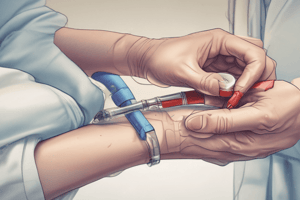Podcast
Questions and Answers
What is the first criterion for considering a tourniquet downgrade or conversion?
What is the first criterion for considering a tourniquet downgrade or conversion?
- It is possible to monitor the wound closely for bleeding
- The tourniquet is not controlling bleeding from an amputated limb (correct)
- The patient is in hemorrhagic shock
- There have been prior successful attempts to remove the tourniquet
What action should be taken if the current tourniquet is ineffective?
What action should be taken if the current tourniquet is ineffective?
- Loosen the existing tourniquet completely
- Tighten the existing tourniquet further or apply a second tourniquet (correct)
- Remove the existing tourniquet and apply a pressure dressing
- Apply a second tourniquet without adjusting the first
What is the primary consideration when downgrading a tourniquet?
What is the primary consideration when downgrading a tourniquet?
- The new tourniquet must be applied directly to the skin at least 2-3 inches above the injury (correct)
- The prior tourniquet must be fully removed before downgrading
- The tourniquet should be applied over a joint
- The wound must be packed with a hemostatic agent
In which situation should a tourniquet NOT be downgraded?
In which situation should a tourniquet NOT be downgraded?
What must be done during the conversion of a tourniquet?
What must be done during the conversion of a tourniquet?
What is the primary purpose of applying a tourniquet?
What is the primary purpose of applying a tourniquet?
What types of bones are recommended for the placement of a Combat Application Tourniquet (C-A-T)?
What types of bones are recommended for the placement of a Combat Application Tourniquet (C-A-T)?
What is a critical precaution to take before applying a tourniquet?
What is a critical precaution to take before applying a tourniquet?
How should the tourniquet be applied in relation to the bleeding site?
How should the tourniquet be applied in relation to the bleeding site?
Which action should be taken immediately after the tourniquet is applied?
Which action should be taken immediately after the tourniquet is applied?
What should be done if bleeding is not controlled after the first tourniquet application?
What should be done if bleeding is not controlled after the first tourniquet application?
What potential damage can occur from incorrectly applied tourniquets?
What potential damage can occur from incorrectly applied tourniquets?
How long can a tourniquet be safely left in place without significant risk of permanent damage?
How long can a tourniquet be safely left in place without significant risk of permanent damage?
Flashcards are hidden until you start studying
Study Notes
Introduction to Tourniquets
- Tourniquets are critical for controlling bleeding from severe hemorrhagic wounds when other methods fail.
- They are especially vital in cases of significant extremity bleeding requiring urgent intervention.
Precautions
- Incorrect tourniquet application can worsen blood loss and potentially lead to death.
- Risk of severe nerve and tissue damage exists regardless of correct application.
- Proper selection of patients for tourniquet use is essential to minimize risks.
- If a tourniquet is removed by a physician within 2 hours, permanent damage is unlikely.
- Prioritizing the avoidance of hypovolemic shock is crucial, even if it increases tissue damage risks.
- Tourniquets should remain visible and not be obscured by clothing.
Procedure for Application
- Initial attempts should focus on controlling bleeding through direct pressure or pressure dressings.
- If unsuccessful, proceed to apply the Combat Application Tourniquet (C-A-T).
- Position the tourniquet 2 to 4 inches above the wound on single-bone structures (humerus, femur) and avoid joints.
- Route the band around the limb and thread it through the inside and outside slits of the buckle for secure application.
- Tighten the band significantly and use the twisting rod to stop bright red bleeding and eliminate the distal pulse.
- Secure the rod in place, check for continued bleeding and pulse; if necessary, apply a second tourniquet.
- Document the time of application on both the tourniquet and the patient (e.g., "TK 20:30"), as well as on a triage tag if applicable.
- Leave the tourniquet uncovered for ongoing monitoring of hemorrhage.
- Maintain the tourniquet during transport, only to be removed by hospital staff.
- Continuously monitor patient vitals and inform all receiving personnel about the tourniquet placement.
- If ineffective, consider tightening the existing tourniquet or applying a second one.
Tourniquet Downgrade or Conversion
- If evacuation is delayed by over two hours, consider downgrading or converting the tourniquet.
- Four criteria for downgrade or conversion include:
- Patient is not in hemorrhagic shock.
- Wound can be monitored closely for bleeding.
- Tourniquet is not controlling bleeding from an amputated or partially amputated limb.
- No previous unsuccessful attempts to remove the tourniquet.
- To downgrade, expose the wound, identify a new location above the injury to apply a new tourniquet while leaving the old one in place.
- For conversion, expose the wound, pack it, apply a pressure dressing, and loosen the prior tourniquet while keeping it in place. Monitor for bleeding afterward.
Studying That Suits You
Use AI to generate personalized quizzes and flashcards to suit your learning preferences.




